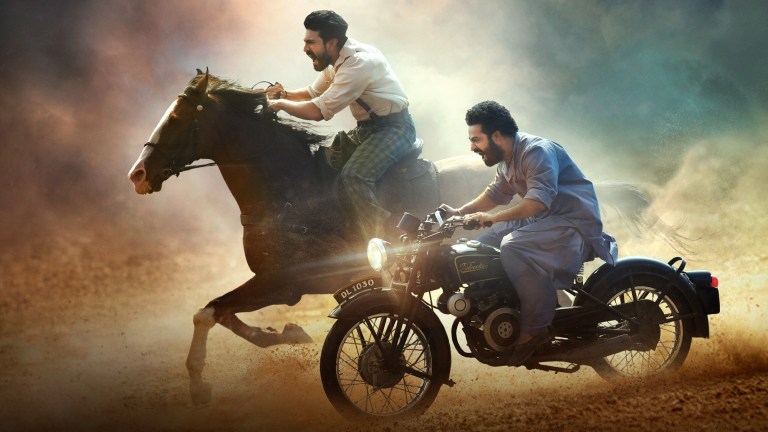RRR: How S.S. Rajamouli Created an Action Movie Phenomenon – Tollywood Style
Exclusive: Director S.S. Rajamouli has made some of the most bombastic, visionary, expensive, and profitable Indian blockbusters to date. As his latest epic, RRR, makes a bid for the 2023 Academy Awards, Den of Geek catches up with this maverick filmmaker.

This article appears in the next issue of DEN OF GEEK magazine. SUBSCRIBE HERE!
If you haven’t tuned into the films of S.S. Rajamouli yet, it’s time to get your mind blown. The Indian filmmaker’s cinematic events are outrageously entertaining, filled with eye-popping cinematography and over-the-top action sequences. The spectacle is so over-the-top, in fact, that you’ve got to park your brain way outside the theater. Heck, give your keys to the valet with a fat tip, or else Rajamouli’s flagrant disregard for the laws of physics might offend you. But if you can suspend your disbelief for a few hours, you’re in for a rollicking treat. Rajamouli makes gloriously panoramic cinema on such a gigantic scale that it begs to be seen on the big screen. This is unabashed and unapologetic fun.
With a budget of ₹550 crore (US$69 million), Rajamouli’s film, RRR, released in March 2022, is India’s most expensive film to date. It is also India’s fourth top box office earner ever. RRR’s overwhelming popularity had fans feeling it was a sure bet for India’s Best International Feature Film candidate at the 2023 Academy Awards, but it was snubbed for a lesser-known film, Chhello Show. “Almost everyone knew that if RRR was sent as the Indian selection for the Oscars, we had a very, very big chance at making it through, but it didn’t happen,” Rajamouli concedes in an interview with Den of Geek magazine.
Undeterred, promoters are launching a major campaign to get RRR nominated in the other categories, including Best Picture, Director, and Original Screenplay (Rajamouli wrote the film with his father and fellow filmmaker, V. Vijayendra Prasad). “We are not the kind of people who get slowed down by hindrances and obstacles,” declares Rajamouli. “We’ll just go forward, and we will do the best we can do and see.”
In 2009, when Slumdog Millionaire won eight Oscars, it felt like Indian cinema finally arrived in the global spotlight. “Bollywood,” the portmanteau of Hollywood and Bombay, entered the industry vernacular. Bombay is the old name for Mumbai, the city that has become a capital of the Indian film industry. However, Bollywood produces films in Hindi, which is just one of well over a dozen languages spoken in India. That sliver of Indian film production also comprises less than half of the nation’s cinematic output.
India’s second most popular language on screen is Telugu. Consequently, there is another industry portmanteau: Tollywood. Although Tollywood produces fewer films than Bollywood, it has racked up many of the country’s biggest box office draws, several of which can be credited to S.S. Rajamouli.
Rise Roar Revolt
RRR is a historical fantasy based loosely on two real-life Indian rebels, Alluri Sitarama Raju (1897–1924, played by Ram Charan) and Komaram Bheem (1900–1940, played by N.T. Rama Rao Jr., a.k.a. NTR). Although these folk heroes never met, RRR imagines that they united to fight against British colonialism in the 1920s. RRR stands for Roudram Ranam Rudhiram in Telugu, which means “Rage War Blood” but has been translated to English as the alliteration-preserving “Rise Roar Revolt.” It is also a play on the three popular filmmakers (R)ajamouli, (R)am Charan, and Rama (R)ao Jr.
The enormous scope of Rajamouli’s action appears in one of the earliest scenes of RRR. To establish Raju’s (a.k.a. Ram—note that this is an abbreviation of Raju’s middle name Sitarama, as well as the name of the actor portraying him) hardcore character, he is introduced at the Anangpur Police Outpost as it is being besieged by a massive mob of enraged protestors (and massive is an understatement here). When a thrown rock shatters a photo of King George V, the commanding officer orders that the perpetrator be arrested. Ram storms into the crowd alone, battling hundreds of rioters with only his lathi baton. It’s a staggeringly violent action sequence, the magnitude of which dwarfs all previous cinematic one-versus-many fight scenes. Ram beats his way through the horde with terrifying resolve and superhuman strength.
“It is a kind of dream for every human being to do things that are beyond the scope of a human being,” Rajamouli explains. “But I feel at the same time giving a superpower also takes away the vulnerability of the character.” Rajamouli says his characters remain human and vulnerable, so when Ram battles through the violent mob, “He can lose at any time.”
RRR gained worldwide exposure through Netflix, which Rajamouli views as both friend and foe. “I’m a filmmaker who grew up in cinemas and who thinks of stories in terms of cinema halls and theaters,” the director says. Rajamouli films are so cinematic they demand to be seen on the big screen. But he can’t deny the impact of Netflix, where RRR was in the Top 10 for 15 consecutive weeks. “I want my film to be released in the theaters first, do fantastic business there, then go on to the streaming platform and reach more audiences who want to watch it again and again in the comfort of their homes.”
Dance Battles
RRR is an epic bromance adventure film, Tollywood style. The hero, Bheem, is a Gond tribesman gone undercover to rescue a girl taken by the British. Ram serves the British police on a mission to track down the undercover tribesman. Unaware of each other’s adversarial roles, the two bond while rescuing a fisherboy from under a bridge where a tanker train explodes. It’s another preposterous action spectacle, an impromptu trapeze stunt where Bheem and Ram fly through, spilling fire whilst dangling from a found rope.
Flying is a common theme in Rajamouli films. “I remember having dreams of flying as a very young kid,” recalls Rajamouli. “And I remember seeing my village from a top angle. So now I wonder how did I conceive that? So I think at the base of it all, my action sequences have some kind of flying to it.”
Beyond the ludicrous action, RRR shares other elements signature to Rajamouli films: themes of loyalty, honor, and karma, expansive panoramic cinematography, sanguineous fight choreography, poignant songs, and, of course, exuberant dance numbers. Often mocked by those unfamiliar with Indian cinema, this genre is measured by the quality of their dance numbers. There’s no separation between action and musicals here, and Rajamouli is a master of the form.
However, RRR only has two major dance sequences: an incendiary dance battle between the heroes and the Brits and a joyful end-credits dance sequence where the director himself joins in. The exhilarating dance battle is choreographed to the chart-topper “Naatu Naatu,” and its signature hook step dance went viral. Like all Indian superstars, both NTR and Charan are renowned for their dancing skills, so fans eagerly anticipated seeing them dance together.
“But the way it was woven into the RRR story is what made even the Westerners really root for them and really, really enjoy the song and dance,” says Rajamouli. He confesses that maybe someday he should try to make a film without a dance number, but that won’t happen soon. “It’s such a strong tool in racking up the audiences’ emotions that I don’t think I will let go of it easily.”
Cultural Gap
Another signature of Rajamouli’s filmmaking style is allusions to Indian classics. Ram is a reference to Lord Rama of one of India’s most beloved love stories, Ramayana, and Bheem is an allusion to Bhima from India’s other legendary epic, Mahabharata. Ram’s fiancée in the film is Sita (Alia Bhatt), as well as historically, just like in the epic Ramayana. This epic tale has been shared throughout Asia in different forms. In Ramayana, Sita is abducted by the demon Ravana and the deity Lord Rama must rescue her with the help of the magical monkey god Hanuman, who acts as a messenger while Sita is imprisoned. This is paralleled in RRR, only Bheem is the messenger, and the modern character Ram is incarcerated. It is also symbolic in RRR when Ram eventually takes a bow from a statue because within the Ramayana, Lord Rama’s bow figures prominently. As for Bheem and Mahabharata, Bhima was renowned for having the physical strength of 10,000 elephants, which is why Bheem exhibits superhuman strength throughout RRR.
When the battles rage in the film, Ram and Bheem become incarnations of these legendary heroes, justifying their superhuman abilities to informed audiences. Nevertheless, Rajamouli doesn’t believe unfamiliarity with Indian religions and legends presents any hindrance. “I feel whether you know the epic or you don’t know the epic, when you’re watching this story, if you connect with the character, which almost everyone does, you flow with the emotion of the story. I don’t think in a good story, the cultural barriers ever exist.”
RRR has caught some flak in the Western press for its excessive depiction of British villainy. It’s a point that Rajamouli is quick to defend. “First of all, RRR is not a historical film,” the director clarifies. “And it’s very clear, even if you can’t read the full disclaimer, in the beginning, the way we start the film itself will make you understand this completely fictional account where there is no political agenda or political propaganda in the film. It is just an emotional tale about these two people.” Despite being based on historical characters and the oppressive history of British colonization and the East India Company, Rajamouli reminds us that “there were many officials, many British people who have done a lot of service to the country.” And there’s one character who is intended to partially redeem some members of the British Empire, Bheem’s love interest Jenny (Olivia Morris).
Says Rajamouli, “It doesn’t mean my intention is to tell the whole world that all British are villains. No, absolutely not.”
Ultimately, Rajamouli refrains from giving any kind of message in his films. For him, it’s all about entertainment. He’s sometimes saddened when people talk less about entertainment. “’It’s just the entertainment that you provide and nothing else?’ they say as if entertainment is a little thing, but for me, providing entertainment is a sacred job.” He hopes his films provide a few hours for people to just forget their daily troubles and rejuvenate themselves, and then go back to their lives. “I really take my job seriously, providing entertainment for the people who pay their hard-earned money and time to come and watch my film.”
RRR is available to stream on Netflix.
